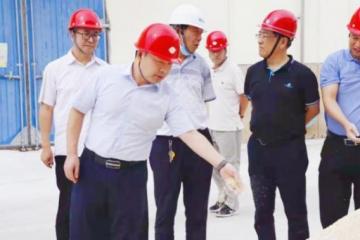SFCMarketsandFinance|Serbianminister
2023-07-15 08:25 来源:证券之星 阅读量:5386
The technological cooperation between Serbia and China has significantly intensified in recent years and a number of successful projects have been implemented, Serbian Minister of Science, Technological Development and Innovation of Serbia said in an exclusive interview withSFC Markets and Finance.
During the pandemic, Begovic participated in the construction of two new Fire Eye laboratories for PCR testing and witnessed China#39;s assistance to Serbia in medical supplies, expert advice and vaccines. She said that Serbia will never forget the valuable support and assistance from China.
According to Begovic, Serbian President Aleksandar Vucic will attend the Belt and Road Forum for International Cooperation held in China this year. The visit will mark the third time for Vucic to attend the BRI forum, after attending the previous editions held in 2017 and 2019.
This year marks the 10th anniversary of the Belt and Road initiative. As one of the first countries to sign a MOU on Cooperation on the Belt and Road Initiative with China, Serbia is also among the very first to benefit from the infrastructure partnership.
Begovic said, joining this initiative not only makes Serbia more visible for China, but also more visible at the global level, attracting a lot of big companies to Serbia. She hoped that the two countries could continue working on technological cooperation under the BRI framework.
She also talked about the Hungary-Serbia Railway, a flagship project under the BRI that has transported three million passengers between Belgrade and Novi Sad, Serbia#39;s two largest cities in first year of operation. She said that she adores this project for its convenience, punctuality and environment-friendliness.
Serbia, China to boost technological cooperation
SFC Markets and Finance: First of all, could you briefly outline the current status of China - Serbia cooperation in science and technology?
Begovic: China has been very active in collaboration in the fields of science, technological development and innovations. Over the years, we really can say that we witnessed the outbreak and significant progress in this collaboration. Both sides have developed different modes, modalities and frameworks for scientific collaboration. Those modes include, for instance, the exchange of students and the exchange of experts, but also mutual collaborative programs in scientific research. There is a huge, I can say, interest of scientists from Serbia for scientific collaboration with China. One of the very nice examples of a very concrete collaboration between our two countries is the presence of the Beijing Genomics Institute with which the government, but also different institutions in Serbia, have a very strong scientific collaboration. Along with this institute and company, at the same time, Serbia developed and invested in the opening of the Serbian Institute for Genetic Sequencing and Bioinformatics within the Institute of Molecular Genetics and Genetical Engineering, which became a very important infrastructure both for medical research, but also for other types of research, including agriculture, environmental protection and similar. So a lot of our researchers are now collaborating with colleagues from different scientific institutions in China.
SFC Markets and Finance: So how many Chinese tech companies are located in Serbia at present? And mainly in what sectors?
Begovic: Actually, I don#39;t have the exact number of tech companies. I have the number of overall companies that have Chinese capital and Chinese companies in Serbia. The number is around 1,500 companies are present in Serbia, and as far as direct investments, from 2014 until 2022, China invested around 4.4 billion U.S. dollars in Serbia. So, this is a strong indication of very tight collaboration, and China also sees Serbia as potentially a very good marketplace. Although Serbia is a small country, the position of Serbia and different cooperational treaties with different parts of the world make Serbia very attractive also for the Chinese investors.And one more thing, which is also important that there are strong incentives from the government for the companies for the foreign direct investments, but also for the companies that are involved in research and development (Ramp;D). So there are additional tax incentives that were adopted by the government in order to really motivate companies to bring their Ramp;D (to) Serbia. So this is our new goal, really, to become an Ramp;D hub within that part of Europe.
SFC Markets and Finance: Could you also illustrate one or two successful cases in this regard? I know you mentioned the gene testing, but just give us some more information on that, like what else companies are doing this in Serbia?
Begovic: For the collaboration with the BGI, we do have constant communication and exchange of experts. Also, BGI opened, for the beginning, a small company that is developing different algorithms for bioinformatics. So for the beginning, they recently opened and employed ten PhDs from Serbia that are experts in bioinformatics, which is a great sign for us that we spread towards biotech, bioinformatics and AI as one of the major fields for the economy. But also, there are a lot of companies like Zhongxing Telecom Equipment . It#39;s a very prominent Chinese telecom company that is involved in the production and development of telecommunication equipment. And this company is not only trading with Serbia, but also they were involved in different infrastructural development projects that happened in Serbia. Regarding the automotive industry, the company Chinese Ling Long is also present in Serbia,and they open a very modern manufacturing plant, bringing new technologies in this facility. So these are some of the examples of the companies present.
Serbian President Vucic to attend BRI Forum
SFC Markets and Finance: Serbia is one of the first countries to assign MOU on cooperationon the Belt and Road Initiative with China. So how do you see the progress of the BRI projects in your country,and its significance to the two countries#39; bilateral relations?
Begovic: Definitely, from the very beginning, from 2013, Serbia has been a great and strong supporter of the Belt and Road Initiative, where we see this visionary project as really a big glow on a global level, a big and important project. Our president, Aleksandar Vucic, attended both forums in 2017 and 2019. And he confirmed his participation on the forum this year, so this is a strong indication of how important this project has been for Serbia. Also, during 2019, a bilateral cooperation program was signed within this forum.
We see this vision as a possibility for Serbia to become more visible for China, for this part of the world, but also more visible at the global level. The results of this Belt and Road Initiative are very visible. And they brought a lot of big companies to Serbia, which really influenced in a positive manner. Also, new job opportunities were opened. The companies that are present in Serbia, for instance, Zijin corporation. They preserved and opened new job positions for people in Serbia, and this is something that is very important for Serbia.
So on a long term, we see these as economic opportunities for Serbia, but also, it#39;s not only about the economy; it#39;s about collaboration in different fields, including science, innovations, technology and cultural collaboration.So I think our two countries have a lot to offer to each other but also a lot to offer to the rest of the world. So we see this initiative as a mechanism for this.
SFC Markets and Finance: This year marks the 10th anniversary of China#39;s BRI. So do you think in the next 10 years, the two countries#39; cooperation in science and technology will further benefit from this initiative?
Begovic: Absolutely. I see science and innovation as a new pillar that should be initiated,and both countries should be working on. I think this is a great opportunity for both countries, including the building of new infrastructures for science, but also in building new scientific ecosystems between our two countries.
Hungary-Serbia railway to revitalize Serbian economy
SFC Markets and Finance: The Hungary-Serbia railway is one of the flagship projects of BRI. So have you personally taken the train yet?
Begovic: Personally, I love it. I adore it, and I use it almost every weekend. So if I speak as a citizen, citizen of Serbia, this has been a huge step forward for the citizens, because Novi Sad and Belgrade, which are two biggest cities in Serbia,became one city, thanks to this railway. In the past, you needed to drive a car, and it took you between an hour and a half, sometimes two hours, to reach Novi Sador from Novi Sad to Belgrade. And now, in 30 minutes, with a speed train, have a cup of coffee, and just read a few mails,you reach the center of both cities. For people who now work in the other city, it#39;s really convenient, so that they don#39;t have to move to find an apartment in another city if they have a job in Belgrade or Novi Sad. They really, very conveniently just travel in 30 minutes, so much faster than a car and other way of transportation. It#39;s also bringing the reduction in the emission of gases and everything. You can count on your time, and you#39;re always punctual, so you can get to the meeting and anything that you want to do in the other city. So I really, personally, love this railway.
SFC Markets and Finance: From the minister#39;s perspective, how will the Serbia government use this railway to promote economic and social development?
Begovic: Once you build the infrastructure between regions, between provinces for the economy, it brings people first closer together. From the small things to the larger things, it connects strongly and closely two cities, which are the economic centers of Serbia. When people move easily, then the ideas move and flow, so there are no obstacles. If you can have two meetings in a day, one in Novi Sad and one in Belgrade, it speeds up the process. Then if you want to build a plant, you can build it somewhere around Novi Sad, but people from Belgrade can really work over there and come back home in the afternoon.So, although they don#39;t seem as big things, they are big things. This infrastructure is just the first part of this project, the high-speed railway between Belgrade and Novi Sad, and so far, around 3 million passengers for one year. We celebrated in March, the first year we used this transportation. We are now in the second stage of building the continuation of this railway towards the city of Subotica in the northern part of Serbia near the border with Budapest.On the other hand, on the Hungarian side, they are building the railway towards Serbia. Once it is connected, it will take us around two and a half (or) three hours to Budapest, the capital of Hungary, which is in the European Union. So this is now a direct, fast connection between Serbia, Hungary and the rest of the European Union. So this is, I would say, a really critical and very important infrastructure for Serbia, for culture, for trading, for economy and for people.
策划:于晓娜
监制:施诗
字幕:实习生王欣桐
制作:实习生焦宇
设计:林军明
新媒体统筹:丁青云 曾婷芳 赖禧 黄达迅
海外运营监制: 黄燕淑
海外运营内容统筹: 张然
海外运营编辑:唐双艳 吴婉婕
海外项目经理:庄欢
海外商务合作: 黄子豪
出品:南方财经全媒体集团
声明:本网转发此文章,旨在为读者提供更多信息资讯,所涉内容不构成投资、消费建议。文章事实如有疑问,请与有关方核实,文章观点非本网观点,仅供读者参考。
为您推荐
热门文章
热文
-
京东发布暑期男女装十大热销榜单CHUU条纹T恤、VVC防晒衣、十三余汉服
-
奇瑞艾瑞泽8高能版轿车发布:鲲鹏动力2.0TGDI、骁龙8155,12.
-
Gartner称2023Q2全球PC出货量下降16.6%:联想下降20.
-
持牌消金发行ABS提速年内发行规模将超87亿元
-
Android14Beta4更新发布,Pixel手机/Fold/Tabl
-
Anthropic发布“GPT-4对手”Claude2大语言模型:性能更
-
倡导旅行与自然的和谐共生马蜂窝发布“中国生态旅行推荐榜”
-
保定公交车减少到只剩333辆如何支撑市民出行?
-
科技昨夜今晨0713:微信称不会显示已读、我国载人登月初步方案公布、“朱
-
瑞能半导体亮相2023慕尼黑上海电子展,加速升级创领功率器件新浪潮








